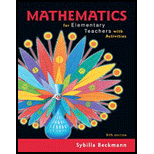
AThe exchanges that follow are taken from Developing Children ‘s Understanding of the Rational Numbers: A New Model and an Experimental Curriculum by Joan Moss and Robbie Case [53, p. 135]. “Experimental Si” and “Experimental S3” are two of the fourth-grade students who participated in an experimental curriculum described in the article.*
*From Journal for Research in Mathematics Education, Vol. 30, No. 2, 122—147 by Robbie Case and Joan Moss. Copyright© 1999 by National Council for Teachers of Mathematics (NCTM). Used by permission of National Council for Teachers of Mathematics (NCTM).
Experimenter: What is 65% of 160?
Experimental S1: Fifty percent (of 160) is 80. I figure 10%, which would be 16. Then I divided by 2, which is 8 (5%) then 16 plus 8 um.. . 24. Then I do 80 plus 24, which would be 104.
For each of the two students’ responses, write strings of equations that correspond to the student’s method for calculating 65% of 160. State which properties of arithmetic were used and where. (Be specific.)
Write your string of equations in the following form:
Want to see the full answer?
Check out a sample textbook solution
Chapter 4 Solutions
Mathematics for Elementary Teachers with Activities (5th Edition)
Additional Math Textbook Solutions
Pathways To Math Literacy (looseleaf)
Precalculus: Mathematics for Calculus (Standalone Book)
Elementary Statistics ( 3rd International Edition ) Isbn:9781260092561
APPLIED STAT.IN BUS.+ECONOMICS
Elementary Statistics Using The Ti-83/84 Plus Calculator, Books A La Carte Edition (5th Edition)
- Select the polynomials below that can be solved using Completing the Square as written. 6m² +12m 8 = 0 Oh²-22x 7 x²+4x-10= 0 x² + 11x 11x 4 = 0arrow_forwardProve that the usual toplogy is firast countble or hot and second countble. ①let cofinte toplogy onx show that Sivast countble or hot and second firast. 3) let (x,d) be matricspace show that is first and second countble. 6 Show that Indiscret toplogy is firstand Second op countble or not.arrow_forwardH.W For any events A and B, show that 1. P(AB)s P(A)≤ P(AUB)≤ P(A) + P(B)arrow_forward
- a) Find the scalars p, q, r, s, k1, and k2. b) Is there a different linearly independent eigenvector associated to either k1 or k2? If yes,find it. If no, briefly explain.arrow_forwardPlz no chatgpt answer Plz Will upvotearrow_forward1/ Solve the following: 1 x + X + cos(3X) -75 -1 2 2 (5+1) e 5² + 5 + 1 3 L -1 1 5² (5²+1) 1 5(5-5)arrow_forward
- Algebra & Trigonometry with Analytic GeometryAlgebraISBN:9781133382119Author:SwokowskiPublisher:Cengage
 Trigonometry (MindTap Course List)TrigonometryISBN:9781305652224Author:Charles P. McKeague, Mark D. TurnerPublisher:Cengage Learning
Trigonometry (MindTap Course List)TrigonometryISBN:9781305652224Author:Charles P. McKeague, Mark D. TurnerPublisher:Cengage Learning

